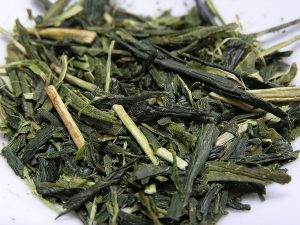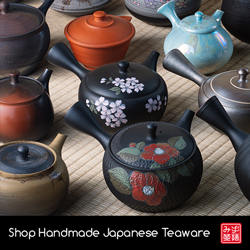
Aracha is a crude tea. This tea has gone through an initial process, but is still unrefined.
The aracha process varies for each type of tea. For this post, we’ll concentrate on sencha.
This process uses machines that are modeled after the temomi process (the traditional hand rolling of sencha).
Just as there are different rolling motions done by hand in the traditional process, there are different rolling machines used in the modern version.
Here’s a list of the general steps in the process:
- Steaming
- Rough rolling
- Rolling and twisting
- Middle rolling
- Fine rolling
- Drying
Let’s go over each one.
Steaming
This is a vital part of the process because it’s where the oxidation is stopped. Remember that green tea is minimally oxidized.
Besides ensuring that the tea actually becomes a green tea, the intensity of the steaming also determines the aroma, color of the liquor, taste, and even the shape of the finished tea.
In addition, steamed tea leaves become softer. This is helpful for the next steps in the process.
There are two types of steaming machines (蒸機) used in Japan: the steam drum, where the tea leaves are agitated and steamed as the drum revolves, and the conveyor steaming machine, where the leaves are steamed as they travel through the conveyor belt.
The first machine is used for sencha, while the latter is often employed for fukamushi sencha and gyokuro.
After leaving the steaming machine, the leaves go through a cooling machine (冷却機). Air cools the tea leaves to room temperature in order to avoid loss of color, taste and aroma.
Rough rolling
To further soften the tea leaves and lower the excess moisture caused by steaming, they are lightly rolled inside the rough rolling machine (粗揉機).
In this primary rolling process, hot air is continuously blown while the leaves are rolled. The leaves are also thrown into the air at each cycle, which helps to reduce moisture.
At the end of the steaming process, the dry basis moisture content (ratio of the weight of water divided by the weight of the tea leaves) is 380%. After the rough rolling, it lowers down to 100%.
For processing fukamushi sencha, which initially has a larger moisture content, before the rough rolling machine there is a tea scattering machine (葉打機). Both machines look very similar.
Rolling and twisting
Stems and stalks are harder to dry than leaves. In the rolling and twisting machine (揉捻機) a uniform moisture content is achieved.
Everything is lumped together and rolled. The tea leaves start to get a better shape.
This step is the only one where heat isn’t applied.
Middle rolling
Since tea leaves still have a high moisture content and their shape is uneven, they must pass through the middle rolling machine (中揉機).
The machine rolls the tea leaves as it rotates, while applying heat at the same time. The lumps of tea leaves are also disentangled as a result.
At the end of this process, the moisture content of the tea leaves drops down to 35%.
Nowadays, another machine is used before the middle rolling machine: the secondary tea rolling dryer (中揉み機). It basically adds more efficiency and quality to the process.
Fine rolling
This is the final part of the rolling process.
The fine rolling machine (精揉機) gives the tea leaves the familiar needle shape of sencha, while also applying heat.
Tea leaves are rolled tighter than before. At a later stage, the machine increases the rolling force.
After fine rolling, the tea leaves have a moisture content of 15%.
Drying
If the tea leaves don’t have a low moisture content, they can’t be stored for a long time.
Again, hot air is used, at about 80 °C to 90 °C (176 °F – 194 °F).
The aracha is now complete, with a moisture content of 5%.
In order to become sencha, aracha has to be refined. I’ll cover that topic in the next post.






December 18, 2018
Very interesting post Ricardo, I’m eager to read the next one.
December 18, 2018
Thank you David.
I’m glad that you liked this post.